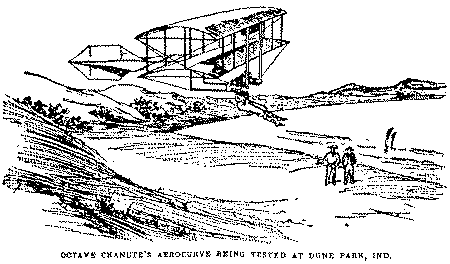Dune Park, Ind. has been deserted by the Albatross and flock of mechanical
birds that Octave Chanute and Inventor William Paul have for some months been trying
to teach how to fly. The creatures have not flown south for the winter. They have
simply been packed in cases and shipped back to Chicago on an Air line freight train.
Owing to adverse winds, the experiments in aerial navigation have not been
entirely satisfactory, but Mr. Chanute and inventor Paul are satisfied with the
season's work and claim to have approached a little nearer to the goal for which
so many inventors have been striving.
Saturday, the north wind that was wanted
for a test of a big Airship Albatross was blowing at the desired velocity of twenty-five
miles an hour, and the test was made. But the wind shifted to the east just as the
craft spread its wings and whirled it into a clump of trees, breaking the left wings
of the machine and bruising Capt. Paul.
Air Coasting Record Broken
This was the final test, and, after coasting for a while with Mr.
Chanute's aerocurves and breaking the world's record for air coasting, it is said,
the machines were packed for shipment.
William Paul is still confident that his airship will prove a success
if it can be launched under proper conditions

Mr. Chanute said yesterday that while he might not be able to devote
as much time to practical experiments in aerial navigation another year, he was
satisfied with what he had accomplished. He had not hoped to see the problem of
aerial navigation solved, but had undertaken the summer's experiments largely for
the purpose of perfecting the aerocurve, and had practically succeeded. He now has
a device that will adjust itself to any condition of the wind; will right itself
and float gradually and safely to the ground, if dropped at any angle or from any
reasonable height.
Success of the Aerocurve.
He has completed a number of aerocurves, capable of sustaining
one person, that have carried passengers from a height of about fifty feet a distance
of nearly 500 feet before reaching terra firma and landed them comfortably and without
jarring.
Small aerocurves, proportionally weighted, have been tossed in the
air at almost every angle and have invariably righted and floated to the ground.
Some have been set adrift upside down, and, like a cat, have "landed on their feet."
These experiments lead Mr. Chanute to believe that he has perfected a parachute,
or aerocurve that solves the problem of aerial balancing and will be safe and useful.